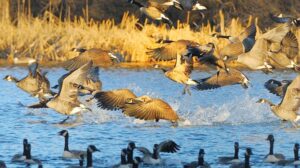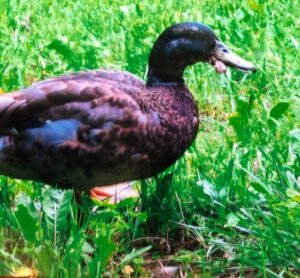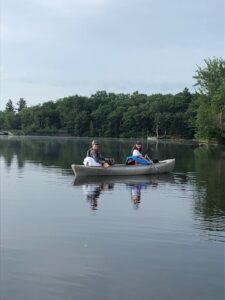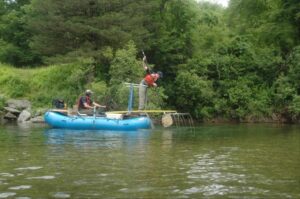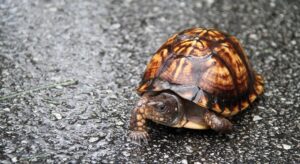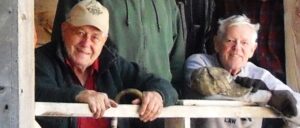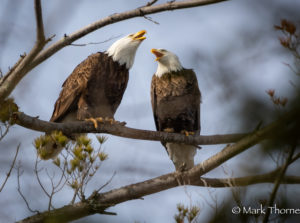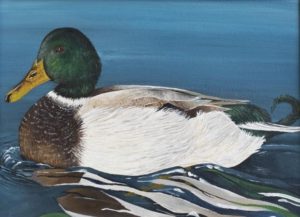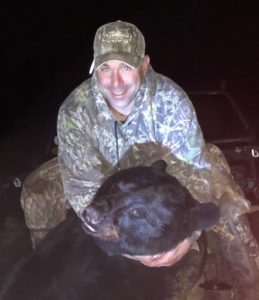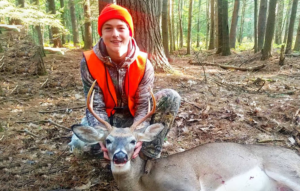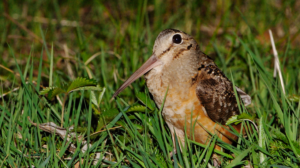The season started with a nice coating of snow which made locating and tracking deer much easier. Local hunters took advantage of the snow and checked in nearly 500 deer after the first week of hunting.
Some 119 deer were checked in at the DFW Western District Headquarters in Dalton, 45 at B & D Variety in Huntington, 121 at Ernie’s Auto Sales in North Adams, 60 at the Lee Sportsmen’s Association, 122 at the Mill River General Store and 32 at Papa’s Healthy Food in Otis.
Michael Winters of Cheshire got a 6-point buck in Egremont which weighed 201 lbs. Eli Pease, DFW Technician, said that it had 4 points on the left side of his head and 2 on the right. He said that it was an old buck, perhaps 6 ½ to 7 years old. Steve Ray of Pittsfield got a nice 189 lbs, 9-point buck in Pittsfield. Dan Kruszyna of Cheshire got an 8-point 190 lbs buck in Cheshire.
The beginning of the second week of shotgun deer hunting started off with rain. During that week, hunters are not required to physically check their deer at a checking station, but have the option of checking them in on-line through MassFishHunt. Therefore, unless hunters chose to physically check in locally, I have no way of finding out about them, not until the figures are released by MassWildlife in Westborough.
As of last Saturday, District Supervisor Andrew Madden felt that the deer tally was comparable with other recent years. Last year, close to 1,000 deer were harvested in the two-week shotgun season for Zones 1 through 4.
Bear hunting tally
The last of the three seasons of bear hunting also ends today. Bear hunters were not required to physically check in their bears at checking stations, but could do so on-line. Some lucky hunters chose to physically check them in and as of last Saturday, 5 bears were recorded with 3 of them being checked in at the Mill River General Store and 2 of them checked in at Papa’s in Otis. Nate Buckhout, DFW Western District biologist, weighed in one in Mill River that tipped the scales at 400 lbs.
We will have to wait for the final bear harvest figures to be released by MassWildlife.
Primitive Firearms deer hunting season opens Monday
Hunters who didn’t get their deer during the Archery or Shotgun seasons have one more chance to connect. Starting this Monday, the Primitive Firearms, (a/k/a Black Powder or Muzzleloader) deer hunting season begins and runs through December 31. Deer may only be taken by a muzzleloader firearm or by bow and arrow. A stamp is required to hunt this season.
Here’s hoping you have an enjoyable, successful and safe muzzleloader hunt. Let people know where you are hunting, be careful, stay hydrated and keep your powder dry.
Other hunting seasons still open
Rabbit, hare, squirrel, coyote and fox hunting seasons resume this Monday. In our zones, duck hunting resumed on December 6 and runs until December 25.
2022 Massachusetts Freshwater Fishing, Hunting and Trapping Laws
Commonly called “the abstracts”, they are out and available in the usual places. The booklet has a cover picture of a big old gobbler.
New for 2022:
- License/Stamp/Permit Fee Increases. I frequently covered the fee increase matter during this past year and you are encouraged to check the details on page 8 of these abstracts.
- New Pheasant/Quail Permit. A permit is now required for any person 15 years or older who hunts, takes, or possesses pheasants or bobwhite quail, unless they were harvested on a licensed commercial shooting preserve. (page 6 of the abstracts).
- Seasonal bag limits for pheasant and quail have been eliminated. Daily and possession bag limits have not changed (page 34 of abstracts).
- Hunting hen pheasants will now be allowed statewide
- Controlled Hunts were eliminated on the Martin Burns Wildlife Management Area in Newbury, MA.
Be sure to read DFW Director Mark S. Tisa’s comments on the future of conservation. Perhaps in the future, I can print his comments verbatim in this column.
2022 Licenses
The 2022 hunting, fishing and sporting licenses, permits and stamps are now available. Most of them can be bought online at mass.gov/massfishhunt with a computer, tablet or smartphone. To purchase them in person, use mass.gov/fishhuntlicensemap to find a license vendor near you. Of course, you can always buy them at our DFW District Headquarters in Dalton.
MassWildlife advises you to use care when purchasing them during December, as both 2020 and 2021 products are available.
Water chestnut pulling campaign
At the November meeting of the MA F&W Board, Western District Fisheries Biologist Leanda Fontaine Gagnon gave an excellent presentation about this past summer’s efforts on controlling water chestnuts on Three Mile Pond Wildlife Management Area (WMA) in Sheffield. The WMA has over 1,000 acres and the pond is within its boundaries. It is a 155-acre enhanced and enlarged great pond with a maximum depth is approximately 10 to 15 feet. It is nutrient rich with a floating island possibly with endangered species.
Water chestnut, an invasive plant native to Asia and parts of Europe, was introduced to North America in the late 1800’s and spread to several states and to Canada.
Because it’s floating rosettes can be up to 2 feet in diameter, it can shade out the native plants. Its 12 to 15 feet root system roots into shallow, nutrient rich lakes with muddy bottoms. Each plant produces a round and spikey fruit. When they drop off and float, they are spread by unsuspecting boaters and waterfowl. And they spread from water body to water body. Despite their being an annual plant, they do spread easily because of this fruit. Each fruit is viable for up to 12 years. Requiring a long-term management project, it can be controlled if caught early.
It was first discovered at Three Mile Pond in 2011. Some brief efforts at removal occurred in 2013, but upon revisiting the site in 2017 it was noticed that it had proliferated to another area of the pond. Extremely dense cover and large patches were noticed in the northwestern cove as well as in the northern cove near a brook inlet.
District personnel began hand pulling in late August and early Sept of 2017 and a more intensive effort was started in 2018 and continued annually.
They learned that pulling in late summer was too late. Most of the plants had already matured fruit and started to drop off and move around in the water body. Green fruit are viable, the black ones typically don’t germinate. They began plucking the plant in the first week of July, where the majority of the fruit had already emerged but the fruit had not matured enough to start dropping.
They hesitated doing drawdowns in Three Mile Pond due to the floating island and endangered species on it. Seeds can be in the mud for 7 years, and could be viable for up to 12 years. Also, they can exist in deeper sediment.
Crews of kayaks paddled out to infected areas, hand pulled and loaded them onto other water-craft which brought them to the boat ramp. There they were offloaded onto pickup trucks which took them to a dump site about ¼ mile away (but still within the WMA) and where no hikers, animals or water sources would bring them back to the pond.
In 2017, with assistance from WD staff, Field Headquarters and Natural Heritage, they removed about 10 truckloads and spent 25 cumulative hours in this removal effort. Each year when they return, they discover less and less plants from the previous year. As early as 2019 there had been significant reduction and native vegetation really started to pop up.
They will continue annual monitoring and removal as they find them, knowing full well that the plants will continue through 2027. Starting in 2028 they intend to start bi-annual harvesting. They hope to implement this removal effort onto other MassWildlife properties such as Mill Pond/Smiley’s Pond in Egremont. That water body also is nutrient rich and deemed to have a considerable water chestnut population, too. They hope to reach out for volunteers to help.

